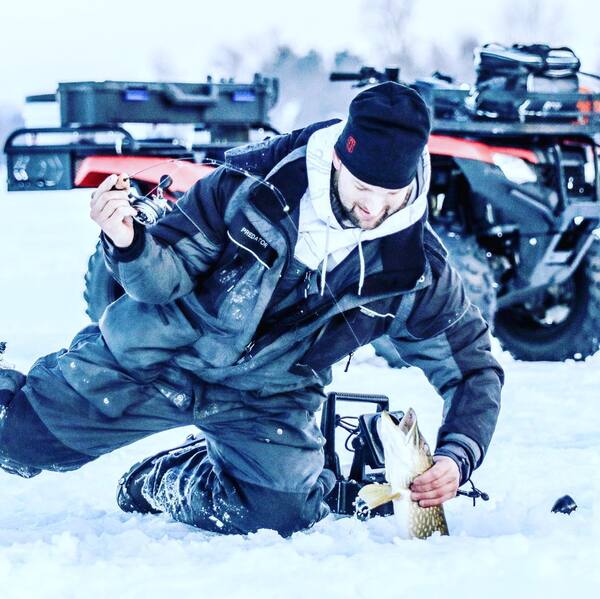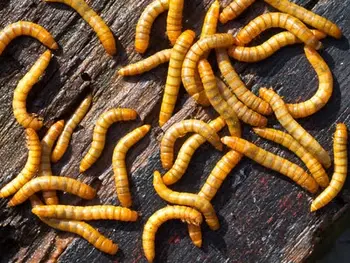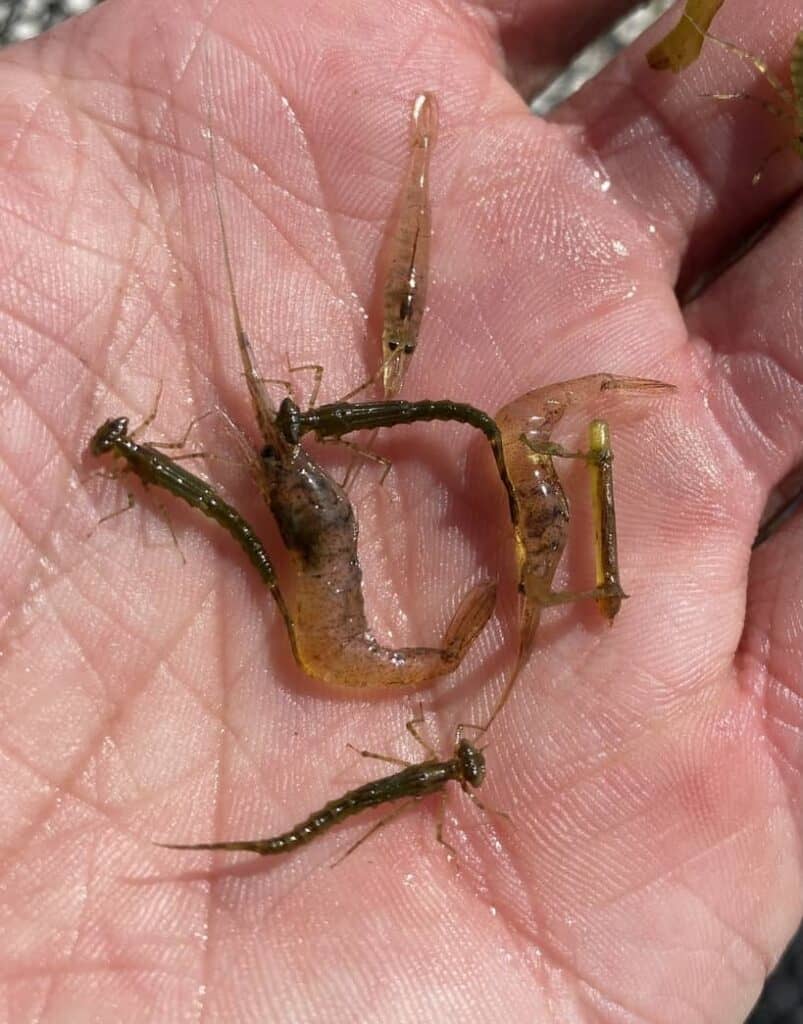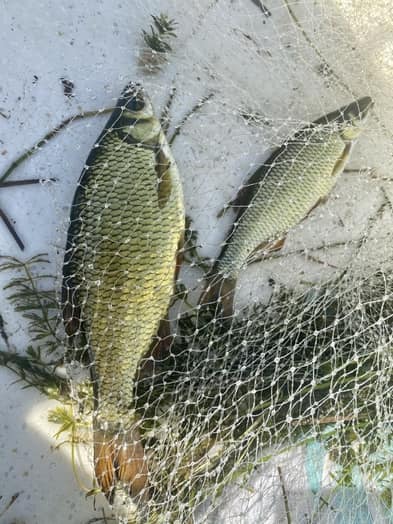Whether you are new to ice fishing, or a seasoned veteran, it’s undeniable that live bait will be your most productive option.
Much of your time spent ice fishing is over a hole without the ability to simply fan cast or troll your area to cover more water.
Live bait will draw fish in the area to your hole because of its natural movement, appearance and scent.
We already know that live bait works, but it is important to understand what to use and when.
In this article, I am going to highlight the 6 best live baits for ice fishing and how to use them.
This page contains affiliate links. As an Amazon Associate, I earn from qualifying purchases.
Table of Contents
Wax Worms “Waxies” (Wax Moth Larva)
Waxies, as they are commonly known, are wax moth larvae that resemble a mini caterpillar with a black head and feet usually around 1/2” length.
They are essentially a parasite in the wild, and can be found in bees nests eating cocoons, bee skin sheds and beeswax.
You’ll find them in coolers at the bait store, as the cold temps put them in a dormant state. This allows them to not eat and remain alive. They are easy to purchase in bulk, to save a little money, and not have to worry about food to keep them alive.

Tipping a tungsten drop jig with wax worms is the most common presentation and arguably the most effective. The soft skin and plump body make it easy to thread on small hooks and easy to handle for kids and adults alike.
They are vulnerable to being stolen or shredded to pieces by the vicious mouths of sunfish, but even just a small ribbon of worm can be enough to entice a bite.
Panfish love waxies but they are also a favorite snack of Salmon, Trout and even Walleye. Don’t be afraid to load your hook with multiple wax worms, this will bulk up the profile, and they have a great flowing natural motion in the water.
Dave Genz The “Godfather of Ice Fishing” is famously known to fill his already plastic tipped jig with 3+ wax worms…they just plain catch fish.
Maggots “Euro Larvae” (Fly Larvae)
Yes, we are talking about the nasty little ¼” worms you find in the dumpster. No need to explain what they eat, its garbage content…

But our friends in the UK use them so much in the fishing world that it has exploded into ice fishing in North America, hence the common name “Euro Larvae”.
Bait stores will have small clear containers of Euros sitting on the counter next to the cash register due to massive demand by ice anglers, or you can order them online. They are natural white or tan colored as well as dyed red, yellow and blue.
Maggots work great as a way to add natural scent and also add to the profile of your bait. Adding a few to a tungsten jig, loading the treble of a spoon or giving some life to ripping bait are all very effective ways to utilize Euro’s.
Anglers lean on maggots for panfish because of how resilient they are due to their tough skin. They will hold up to multiple fish catches before you need to add more.
After taking a beating, they still add a lively natural action that will activate bite reactions from fish as well.
Mealworms
Mealworms are a select choice for some ice fishermen. During this larval stage in their life cycle, they will feed on vegetation and decaying material. They make a hearty meal for many species of freshwater fish.

Not traditionally used as bait they’ve found a place in the panfish world. You may need to visit a pet store as opposed to a bait store to find them. Mealworms boast a beefy armor like skin that makes them resilient to multiple catches.
Natural scent is once again a key benefit to using mealworms as bait. Its ¾” size is well suited for small jigs as well as treble hooks.
See Also: The 8 Most Common Types Of Fishing Worms (W/Pics!)
Though its shell-like skin does not bode well for natural movement, mealworms are hearty and will stay alive for a while, showcasing their true natural action.
Trout chow on mealworms during the winter months as it resembles common grub-like forage. Their lively action will allow for a more finesse presentation of micro jigs or bare hooks to draw the attention of spooky-natured trout.
Freshwater Shrimp
A number of lakes across the ice belt hold healthy populations of freshwater shrimp, which pose a protein-packed snack for any fish. These filter feeders can be found near algae-ridden areas like weed beds.
You will need to get creative if you choose freshwater shrimp as your bait of choice. Bait stores will not often if ever carry them so once again you’ll have to visit the pet store.

A more ambitious angler than I might search the mudflats with traps to collect their own stock of bait. If you’re lucky you might just drill a hole in the ice, and be gifted with freshwater shrimp, not only saving money but also pointing you to the fish.
They will not stay alive for long after you place them on a hook. Shrimp are best suited on a jig head, or spoon with lots of flash and action to match a shrimps natural movement.
You will rely on the unique natural scent of the shrimp to attract your targets.
The list of species to target is wide as it is such a unique natural presentation, but Trout, yellow perch and walleye are the most common with shrimp on the menu.
Minnows
Last but certainly not least is the crowd favorite and most versatile on the list, Minnows. Commonly referred to as bait fish as they are easy small targets for predators.
There are several species of minnows that are each used for very specific game fish targets.
Below is a summary of the most commonly used minnows with tips about what species of fish and presentation is best suited for its use.
Each of these listed will generally be easy to find in any local bait shop, or you can always save a few bucks and catch your own.
Crappie Minnow
The name says it all, these 2.5” silver bait fish are the prime, live bait selection of an ice angler targeting Crappies.
You can hook them through the head on a jig or Rip the tail off and place them on the treble hooks of a spoon for added scent and natural action.
A plain hook through the dorsal fin under a small bobber is a great confidence presentation for crappies as well.
Fathead Minnow
In essence, Fatheads are just grown up crappie minnows. They present similarly and can be fished the same on large tackle due to their size.
Walleye & Bass love fatheads, but large crappies aren’t scared to prey on these larger minnows as well. Fishing with these beefy minnows will make a day on the ice exciting, you never know what you’ll reel in.
Shiner Minnow
What’s in a name? Everything, it rang true with the crappie minnow and again here with the shiner minnow.
Their discoball-like scales are sure to catch the eye of any hungry predator. They can be found in sizes from 2.5” up to 4” or even larger.

Anglers often chose to lightly hook shiners under the dorsal fin and drop them below a bobber or tip up targeting walleye & pike.
Shiners can be delicate, so water temp changes or other bait fish in the bucket, can quickly kill them. Try to place them in a separate bait container if using other species of minnows as well.
Lake trout love dead shiners/cisco laying on the bottom as well so dead shiners are not a loss if lakers are nearby.
You May Also Like: How To Keep Minnows Alive Without an Aerator (7 Tips)
Sucker Minnow
Anglers chasing the fight from some “toothy” fish like Pike & Walleye will opt for the use of sucker minnows. In most cases 4” + size suckers are rigged on quick-strike rigs with two treble hooks under a tip-up or set line.
Pike will grab your bait and swim while they eat so the two treble hooks make it easy to get penetration no matter how far they swim away.
Walleye will take your bait in a similar fashion but will be deterred by multiple large hooks, so smaller-size suckers with a single treble or octopus hook work best.
The Best Live Bait For Ice Fishing
Hands down without a doubt if I’m going ice fishing I will have a container of wax worms on me.

Whether it’s a confidence bait or not, waxies flat-out produce fish day in and out. You can add them to almost any presentation without compromising bite and they are on the lower end of the scale in terms of cost.
Grab some waxies and a noodle rod with a jig and you will “pinwheel” fish all day long!
If you haven’t guessed yet, I love fishing and everything about it!
To learn more about why I started Panfish Nation, visit the About page and follow along on Social Media:


Download a copy of my FREE Lure Color Selection Chart & Knot Guide!
Stay up to date with fishing reports, tackle reviews, industry news, and much more! We respect your privacy, unsubscribe at any time.
